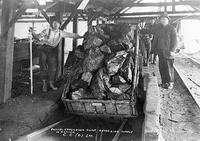Mining
MINING is the third-largest industry in BC in dollar value after the FOREST INDUSTRY and TOURISM. In 2010 mineral output was worth $7.9 billion in revenue (excluding petroleum and natural gas; see OIL AND GAS INDUSTRY). Net COAL revenues were $3.4 billion; COPPER revenues $1.4 billion; GOLD revenues $224 million; ZINC revenues $755 million; SILVER $416 million. There were 18 producing mines in the province, down from 30 major mines in operation at the beginning of the 1990s, but exploration was expanding rapidly with a rise in international commodity prices on which the industry is highly dependent. Mining employed 8,195 people in BC, 40% in the coal sector.
Mining History to World War I
BC is one of the world's major mining regions, thanks to its location in the mineral-rich CORDILLERA of western N America. The first mining in the province was undertaken by the HBC in search of coal on northern VANCOUVER ISLAND in 1849 and NANAIMO in 1852 (see COAL MINING, VANCOUVER ISLAND). Gold discoveries during the 1850s led to the GOLD RUSH on the FRASER R in 1858, extending into the CARIBOO in the early 1860s. This rush led to the creation of the mainland colony of British Columbia and to the construction of the first roads into the Interior. This was placer mining, for the most part producing gold recovered from stream deposits either on the surface or in deep buried channels, requiring little equipment or organization. Subsequent gold rushes into the Omineca and CASSIAR areas were less productive, but until 1884 gold was the leading mineral produced in BC in terms of value.
The next important mining area was the KOOTENAY, where hardrock, or lode, mining required processing to remove metals from the ores and a transportation network to carry material to SMELTERS and then to market—in other words, capital and organization on a scale not known to the gold prospectors of the Cariboo. The first major discovery was the Silver King mine near NELSON (1887), followed by copper–gold near ROSSLAND (1890), silver–lead in the SLOCAN (1891), lead–zinc near KIMBERLEY (1892) and the silver–lead St Eugene Mine near MOYIE (1893). In the neighbouring BOUNDARY DISTRICT, copper was the basis of the industry, with mines at GREENWOOD, MIDWAY and PHOENIX supplying a smelter at GRAND FORKS; while it was in operation (1900–19), it was the second-largest copper smelter in the world. During the mining boom from 1886 to 1900 more than 1,300 mining companies were formed. Initially much of the interest and financing came from the western US, where mining had been booming since the 1860s, while Ontario and Quebec were as yet unaware of their tremendous mineral potential. In 1896 F.A. HEINZE, a smelter owner from Butte, MT, opened a smelter at TRAIL, later acquired by the CPR and merged into its mining subsidiary COMINCO in 1906. Mining in this area benefited from intense competition for traffic between the CPR and its American rivals, chiefly James J. Hill's GREAT NORTHERN RWY. Not only did the railways carry product to market, they also created a demand for fuel that, along with the need for coke at the new metal smelters, led to the first coal mining in the southeast corner of the province in the valley of the ELK R. By WWI, precious metals (gold and silver) accounted for 36% of the value of mineral production while copper accounted for 35% and coal 25%. Hardrock mining in the Kootenay led to much of the first formal labour organization in BC and helped to establish the province's tradition of labour militancy (see INTERNATIONAL UNION OF MINE, MILL & SMELTER WORKERS; LABOUR MOVEMENT; WESTERN FEDERATION OF MINERS).
Mining History Post-World War I
Following WWI, as first ships, then railways, converted to oil as their main fuel, coal mining went into a slump. But the market for other minerals—lead, zinc and copper—remained healthy. By the 1930s the copper mines at BRITANNIA were the most productive in the British Empire, supplemented by the Granby copper mine at ANYOX until it closed in 1935. At the same time the SULLIVAN MINE, owned by Cominco, was the world's largest lead–zinc producer and the BRALORNE and PIONEER mines in the BRIDGE R country were important gold producers. Prior to the 1950s nearly all mining in BC was underground. After mid-century, open-pit production became feasible and several huge copper mines opened, including the Craigmont Mine near MERRITT (1961–82), Highland Valley Copper, the largest open-pit operation in N America at LOGAN LAKE near KAMLOOPS, and the ISLAND COPPER MINE (1971–95) near PORT HARDY. Likewise ASBESTOS was mined at Cassiar (1952–92), MOLYBDENUM at ENDAKO starting in 1965 and silver at the Equity mine near HOUSTON. Coal mining rallied in the late 1960s with the development of fields in the southeast corner of the province, principally to fuel the Japanese steel industry. This was followed by development of the northeast coalfields at TUMBLER RIDGE. In 2016 there were still 6 coal mines in production in BC but a concern about greenhouse gas emissions was leading markets to seek alternative, "cleaner" energy sources and the future of coal looked dim. Mine openings during the 1990s include the Huckleberry molybdenum–copper mine south of Houston (1997), the Mount Polley gold–copper mine northeast of WILLIAMS LAKE (1997) and the Kemess gold–copper mine 350 km north of PRINCE GEORGE (1998). None of these developments changed a fundamental fact about the BC mining industry: that it has prospered as an exporter of raw materials but with the exception of the smelters at Trail and KITIMAT, it has failed to develop related manufacturing industries in the province. See chart.


